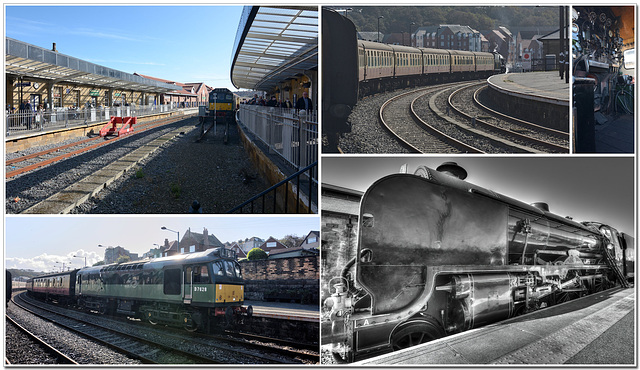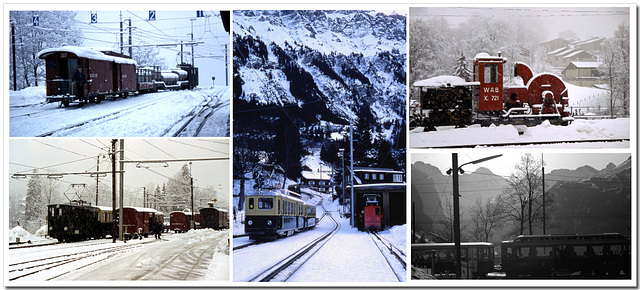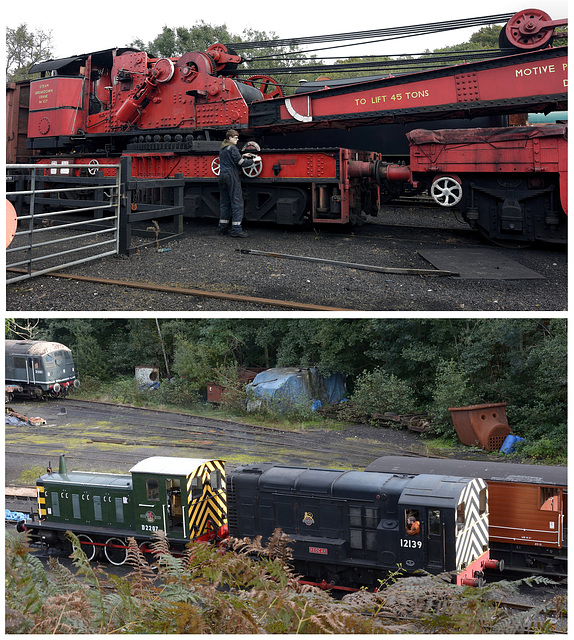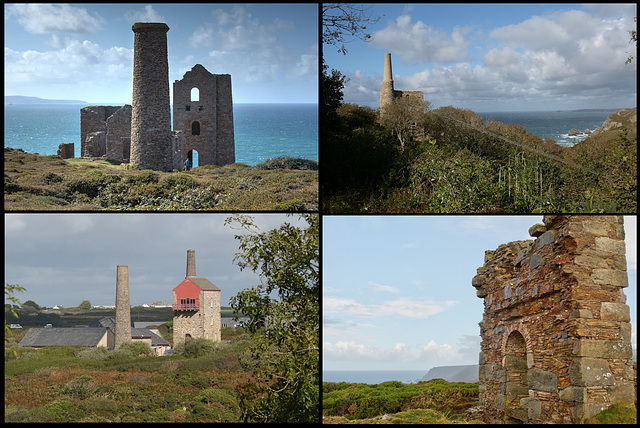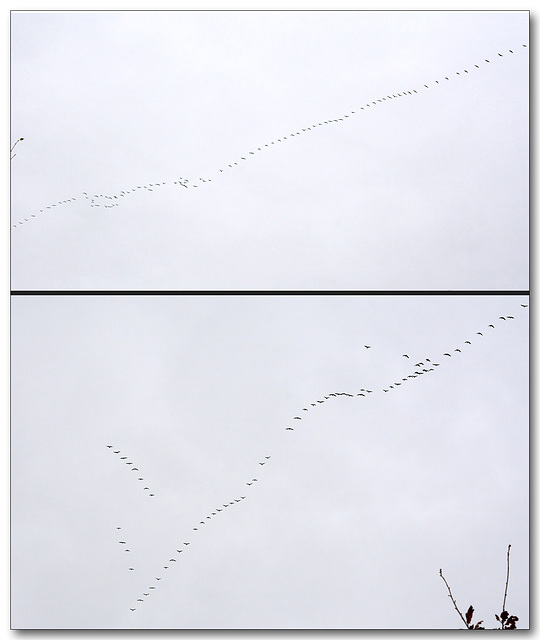
Collages
20 Sep 2020
16 favorites
19 comments
Whitby Railway station with trains from the NYMR
Whitby's original railway station stood near to the end of the current platform, in the form of the offices, workshop and carriage shed of the Whitby and Pickering Railway; a single track horse worked line opened throughout in 1836. Its engineer was George Stephenson. It has been run through the years by W&P, Y&MR, NER, LNER and finally British Railways. Now it’s quite different after many modifications completed in 2014 allowing by 2020: 4-5 trains per day from the heritage line of the North Yorkshire Moors Railway (NYMR) and six a day by the present ‘Northern Line’ which is part of our National Railway system.
Here we see, left the diesel having just arrived from Grosmont and the steam engine Repton on the right making ready for departure.
Diesel No. D7328: BR Class 25 “Sybilla” –Built in Manchester by Beyer Peacock (Sulzer Ltd), entered service in 1965. Withdrawn 1987 from Cricklewood East after 24 years 10 months. BO-Bo wheel arrangement.
Steam Locomotive: SR No. 926 “Repton” - ‘The Opimist’, SR Class V ‘Schools’ 4-4-0. Built in Eastleigh and entered service in 1934, withdrawn in 1962 at Basingstoke after 28 years of service. Worked for Southern Railway and British Railways. (was No. 30926 from 1948-62)
Best full screen.
Ps someday, I shall make a mini-series of all these trains in their full glory.
The mountain narrow gauge railways of Wengen, Switzerland c1984
Here is a selection of the trains running on those mountains at that time, now long superceded.
The Wengernalp Railway (WAB) is a 19.11 kilometres long, rack railway line in Switzerland. It runs from Lauterbrunnen to Grindelwald via Wengen and Kleine Scheidegg at 2,061 metres above sea level, making it the world's longest continuous rack and pinion railway. The name refers to the seasonal mountain pastures above Wengen. It has a track gauge of 800mm (2'7", UK=1435mm)
Originals on 35mm slide. Nice full screen.
06 Jan 2020
23 favorites
28 comments
African Safari postcard
Scenes from our mini-safari near Port Elizabeth, South Africa in 2014.
Nice full screen
Click on PiP in top left of each picture for bigger views.
21 Feb 2019
30 favorites
39 comments
Its Crocus day!
Happy crocus day -well it may not be officially, but it is for me. A couple of hours of February warm sun in our garden brings out these early Spring flowers. A moment of joy in our household and maybe to you here too.
Enjoy.
Crocus is a genus of flowering plants in the iris family comprising 90 species of perennials growing from corms. Many are cultivated for their flowers appearing in autumn, winter, or spring. The spice saffron is obtained from the stigmas of Crocus sativus, an autumn-blooming species. Wikipedia
01 Apr 2021
19 favorites
18 comments
Port Mulgrave, its rust and history
Sitting in the old port area, at the end of the ruined pier are the remains of a possible portable crane or winch. The bottom left photo is a coil of metallic cable no doubt used for the winch now on its last legs of existence –a solid rusted mass. The top right shows what I imagine to be the top of another winch nearer to the old tunnel that brought the workers and ore here from nearby dwellings and quarries.
The harbour was constructed by Sir Charles Palmer in 1856-57 at a cost of £45,000. Initially the harbour exported ironstone to Jarrow on Tyneside to supply Palmers Shipbuilding and Iron Company Limited Later ironstone was sent to blast furnaces by the River Tees When the mine at Rosedale Wyke began to run out Sir Charles Palmer established Grinkle ironstone mine 3 miles (4.8 km) to the east near the hamlet of Dalehouse and in 1875 a narrow-gauge railway line was built to the mine. The ironstone wagons from Grinkle Mine were taken over bridges then through a tunnel under Ridge Lane down a mile long inclined tunnel on a ropeway powered by a steam engine situated by the east pier then emerging in the cliff side 30 ft above sea level. The railway wagons were then led onto a gantry with bunkers on the east harbour wall ready for loading the ironstone directly into ships in the harbour.
See the tunnel photo for the full history.
Enjoy full screen.
24 Jun 2021
5 favorites
6 comments
NYMR Yard snaps
Behind the Grosmont workshops.
The red Steam Breakdown Crane No 107 was built around 1929 and can lift up to 45 tons. This was in use, in its day, at Doncaster, Yorkshire.
12139 is a Class 11 0-6-0 type of diesel-electric shunter, built to an LMS design at English Electric at Preston in 1948, shown here in British Railways black livery.
BR Class 04 D2207. The British Rail Class 04 was a 0-6-0 diesel-mechanical shunting locomotive class, built between 1952 and 1962 and was the basis for the later Class 03 built in the British Railways workshops.
08 Aug 2021
22 favorites
14 comments
Carnforth Railway Station
The market town of Carnforth in Lancashire is the setting of these photos aimed mainly at its old railway station. Sitting on the ‘West Coast’ railway line, it has always been busy, especially with its close proximity to the Lancaster canal and A6/M6 roads. The town was well known for being a ‘railway town in the 19th century as being at the junction of three major railways. The station was made famous by it being the setting for the 1945 ‘Brief Encounter’ film, refreshment room set (top centre). Alongside this station on the old wagon works and sidings used to be a very big train museum called ‘Steamtown’ that ran from 1967, sadly closed to the public in 1987 but is now run as the ‘West Coast Railway Company’ which operate heritage steam and diesel trains across the UK railway network. Unfortunately there is no public entrance allowed for me to explore there.
The collage photos are self explanatory but the yellow train coming in, is an Avanti West Coast, Pendolino class 390 from Glasgow to London.
Enjoy full screen.
20 Nov 2021
19 favorites
17 comments
The mines of St Agnes
St Agnes in Cornwall is the home to many old mines and here is a small collection of their engine houses. These mined mostly copper and/or tin often from the early Bronze age up to the beginning of the 20th century when these metals either ran low or were mined much cheaper elsewhere. This is ‘Poldark’ country and it seemed on our brief visit around here that there were mines around every corner. Other minerals were also mined including gold, zinc, silver, lithium and arsenic. Cornwall’s neighbour; Devon, also has many such mines.
Top row from left is the top of Wheal Coates and one of the Polberro Mines. Bottom from left is Wheal Kitty and then Wheal Charlotte which sits just south of St Agnes Head. Only Wheal Kitty now survives of these, as a visitors centre with workshops and a café.
The PiP shows a view of the bottom engine house of Wheal Coates.
Enjoy full screen.
21 Nov 2021
26 favorites
21 comments
Flying south for the Winter
A loud honking of duck/geese calls draws our attention up to the skies where we see a very large flock of migratory ducks or geese heading south (right to left here). I don’t think I have ever seen such a large flock with even more there than my two photos reveal. There was at least another length as big as the top photo that I missed to capture.
As to what kind they were, we could not tell, even from close ups with my original large RAW pictures but we do have, generally much smaller flocks of Canada geese passing us at times and so it might be the same. I include a PiP of my blow up, maybe you can tell what kind they are.
Enjoy full screen.
Jump to top
RSS feed- Latest items - Subscribe to the latest items added to this album
- ipernity © 2007-2024
- Help & Contact
|
Club news
|
About ipernity
|
History |
ipernity Club & Prices |
Guide of good conduct
Donate | Group guidelines | Privacy policy | Terms of use | Statutes | In memoria -
Facebook
Twitter

